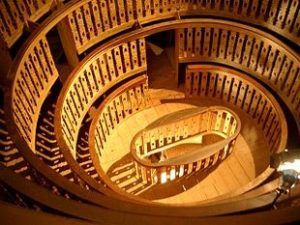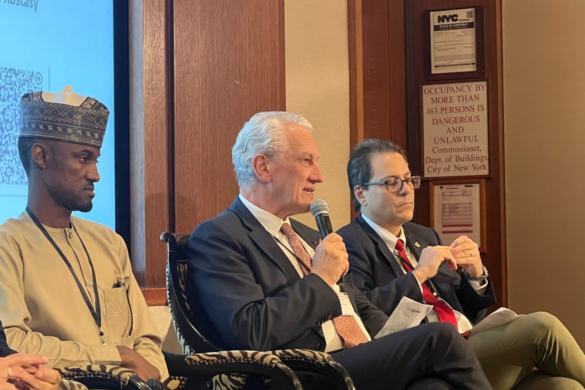General information on the country
Our cities are well known for the arts, their history , design and fashion, quality of life, and food. The Mediterranean diet was postulated to be protective against neurodegenerative diseases by Ancel Benjamin Keys (1904 – 2004), a famous American physiologist who decided to live in the Cilento, a beautiful Southern Italian area, and follow the diet himself. Finally, Italian cities are renowned for the human relationships of their inhabitants.
Fig. 1. A miniature depicting the Schola Medica Salernitana from a copy of Avicenna’s Canons
The Italian health system
Italian healthcare has been fully public since 1970, with the majority of the hospitals administered by the Regions, who are also in charge of primary care. Private hospitals exist , some of which may be also fully supported by the Regions. Pure private clinical practice is possible.
Italian citizens receive gratuity assistance for hospital care; they have to pay a ticket related to their salary for outclinic patient care and for medication .
The Italian university system and the medical school
The majority of the Italian Higher Education system is public, including the leading Universities. We have many historic Universities, with a long tradition of more than 7 centuries, for example in Bologna (founded in 1088), Padua (founded in 1222), Naples ( founded in 1224), and Siena (1240) ( fig 2-4). There are around 90 universities in Italy and 40 medical schools, the majority of which are public ( 4 private). Access to medical school is regulated by national selection, after a multiple choice examination.
Fig 2. The anatomical theatre of Padua University, by Girolamo Fabrici d’Acquapendente in 1594, professor of anatomy, physiology and surgery.
Fig 3. Bologna is the oldest Italian University, founded in 1088.
Santa Maria della Scala (Siena) was one of Europe’s first hospitals and one of the oldest hospitals in the world, surviving as a hospital until a few decades ago. 4 b and c. Frescoes in the Pilgrim’s Hall by Domenico di Bartolo
Post-graduate schools of neurology
Neurology post-graduate schools in Italy are linked with the universities and university hospitals. An agreement may be also present with non-university Hospitals. The duration of post-graduate training is 4 years. Access is regulated by a national multiple choice examination, with similar rules to access to medical school. Neurologists in training receive a salary (1800 euros/month) and their activity is divided between clinical practice, teaching courses and at least three research projects and drug trials. Training concludes with discussion of a thesis. At least 160 new positions are present every year, distributed between the different schools. There are currently 169 neurologists in training across the schools.
A history of Italian neurology
The history of Italian neurology has long been bound up with the treatment and study of mental disorders: the Società Frenopatica Italiana (Italian Phrenopathic Society) was founded in 1861 with the aim of studying the anatomy and physiology of the brain and nerves, as well as organising hospitals for the treatment of mental illness.
In the early 1900s, several scientists, involved mainly in investigation of the anatomy and physiology of the central and peripheral nervous system and its pathological conditions, began to see the utility of autonomous development of the neurosciences as a separate field. They created the Italian Society of Neurology (Società Italiana di Neurologia, SIN), which was officially founded in 1907 with Leonardo Bianchi, professor at the University of Naples as its first president. The individuals involved in this endeavour were the founders of the modern Italian neurology: Leonardo Bianchi, Carlo Besta, Amico Bignami, Ugo Cerletti, Cesare Lombroso, Giovanni Mingazzini, Onofrio Fragnito, Ottorino Rossi, Camillo Negro, Enrico Morselli, Eugenio Tanzi, Ernesto Lugaro, Camillo Golgi, and others (Fig. 4-9). These founders of Italian neurology came from various prestigious Italian neurological schools: the school of Turin, founded by Cesare Lombroso, Camillo Negro, Ernesto Lugaro, and Dino Bolsi; the school of Rome, with Giovanni Mingazzini, Ugo Cerletti, who developed electric shock strategies for treatment of behavioral disorders, and Guido Gozzano , one of the founders of the modern electrophysiology; the school of Pavia with Cesare Lombroso (who subsequently moved to Turin), Casimiro Mondino and Ottorino Rossi; the school of Naples with Leonardo Bianchi and Vito Maria Buscaino.
Fig. 5 – Leonardo Bianchi, the first President of the Italian Society of Neurology, professor in Naples.
Fig. 6 – Gaetano Perusini, one of the first neurologists describing the clinical and neuropathologic findings of senile dementia, after known as Alzheimer’s disease.
Fig 7. Drawings by Gaetano Perusini reporting neurons in various stages of neurofibrillary alteration.
Fig 8 – Camillo Golgi (1843 – 1926), Nobel Prize in 1908.
Fig.9 – The hippocampus in a drawing by Golgi
Fig. 10 – Giovanni Mingazzini (1859 – 1929). Professor at University of Rome. He described the Mingazzini’s maneuvre, to detect minor degrees of paresis.
Fig.11 – Rita Levi-Montalcini (1909 – 2012), neurologist, neuroscientist, Nobel Prize, 1986. She was educated at Turin University, where she worked until 1946, when she immigrated in USA. She came back to Italy after 1960, becoming director of the Neuroscience Centre at CNR, Rome. She was also President of the Multiple Sclerosis Foundation and a life-senator.
In the period between the Second World War and the end of the 1950s, services for the treatment of neurological and mental disorders were generally located in psychiatric hospitals and the discipline was centred in Clinica delle Malattie Nervose e Mentali (Nervous and Mental Diseases Clinics). Subsequently, in several hospitals, specialist units of neurology and neuropathology were created, separated from general medicine units but, until 1960, the laws governing the general organisation of hospitals did not make provision for units of neurology in all major hospitals. Indeed, only a handful of neuropathology units existed, in large cities such as Genoa, Milan, Rome, Turin, and others.
From 1970 onwards, the Italian Society of Neurology saw major changes, acquiring a more modern internal organisation structure. Neurology became separate from psychiatry and the Clinics of Mental and Nervous System Diseases started to be called Neurology Departments. In the universities, the professors of nervous and mental diseases preferred to be known as professors of neurology, splitting their teaching into neurology and psychiatry. Numerous subspecialities started to emerge and develop, attracting growing interest from young generations of neurologists interested in neuropsychology, neuropathology, clinical neurophysiology, clinical neurochemistry, neurogenetics, neuroimmunology, neuroimaging, neurorehabilitation, neurophthalmology, and other disciplines.
The SIN board is renewed every two years. Many members greatly contributed to the development of modern neurology in Italy , some of them with great international reputations. We remember our former Presidents, Luigi Amaducci (Florence), for his work with the European Federation of Neurological Societies and the European Union for development of research mainly in neuroepidemiology and dementia, Cesare Fieschi (Rome) for his contributions to vascular diseases and stroke care organisation, and Elio Lugaresi (Bologna) for his contributions to sleep research (fig 12-14).
Fig. 12 – Luigi Amaducci (1932-98), University of Florence
Fig 13 – Cesare Fieschi ( 1932-2016), University of Rome La Sapienza
Fig 14 – Elio Lugaresi ( 1926-2015), University of Bologna
Renato Boeri, who was director of the Istituto Neurologico Besta founded the Italian Journal of Neurological Sciences in 1979, which became the SIN’s official voice. Called Neurological Sciences since 2003, over the years it acquired considerable international stature (Fig. 15) increasing in the recent years its impact factor to 2.289.
Fig. 15– Neurological Sciences, Editor in Chief (2013-up-to-date) Antonio Federico.
Italian neurology: the present and future
In 2007, the Italian Society of Neurology celebrated its centenary and a book has been published, marking this milestone (Cento Anni della Società Italiana di Neurologia: le Origini e gli Sviluppi. Siena; Tipografia Senese s.n.c. 2011). Today, the Italian Society of Neurology has more than 2600 members, 19 study groups and 16 adherent societies ,all of them active in different branches of the neurological sciences; it now has two journals, Neurological Sciences, published in English, and Neurologia Italiana, published in Italian. Numerous activities promote research and organisation of neurological care in Italy; activities at international level are pursued. The passing years have seen major changes in composition of the membership of the Italian Society of Neurology, with increasing proportions of women and of young people. SIN has a website (www.neuro.it ) with further information on Italian neurology.
As far as Italian neurological research is concerned, despite challenges related to central economic support, neurology is, compared with other disciplines, one of the most active areas of research in Italy. If we look at the number of articles published by Italian neurologists in the leading international journals (Fig. 16), a linear increment is present over the years, taking Italy to third position in Europe (Cruccu et al, 2017 ).
Currently, Italian neurologists are highly involved in emergency care including stroke, as well as the treatment of complex and chronic neurological disorders. Emergency, complexity and chronicity are considered different aspects of the same conditions and the ethos is that it is only through integration of science, therapeutics, teaching and relationships with patients and caregivers that we might achieve a more effective approach to the care of patients with neurological diseases.
Fig 16 – Scientific outputs in the leading clinical neurological journals in Europe (Cruccu et al, Europ. J. Neurol. 2017)
In recognition of the prominence of Italian neurology and Italian neurologists on the international stage, the 2021 World Federation of Neurology Congress will be held in Rome, 60 years after the last WFN congress in Italy. We warmly invite all of you (fig 17).
Fig 17 – Welcome to Rome for the 2021 World Congress of Neurology
by Antonio FEDERICO* and Gianluigi MANCARDI**
*SIN Past-President, Editor-in-chief Neurological Sciences and EAN Italian delegate
** SIN President































